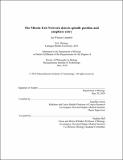The Mitotic Exit Network detects spindle position and anaphase entry
Author(s)
Campbell, Ian Winsten.
Download1117709695-MIT.pdf (32.96Mb)
Other Contributors
Massachusetts Institute of Technology. Department of Biology.
Advisor
Angelika Amon.
Terms of use
Metadata
Show full item recordAbstract
The Mitotic Exit Network (MEN), an essential GTPase signal-transduction cascade, controls mitotic exit in budding yeast. The MEN protects genomic integrity by ensuring chromosome segregation is complete prior to cytokinesis. Two signals are required for MEN activation: (1) movement of the nucleus into the daughter cell and (2) anaphase onset. These two events only coincide after anaphase chromosome segregation, ensuring that mitosis is complete prior to cytokinesis. The MEN is regulated by spindle position. The MEN GTPase, Tem1, is inhibited as long as the entire spindle resides in the mother cell. Tem1 becomes active when spindle elongation along the mother-daughter axis drives half of the nucleus into the bud. If spindle elongation fails to move part of the nucleus into the daughter cell, MEN activation is prevented, providing time to reposition the spindle. In addition to this spatial regulation, activation of the MEN is restricted to anaphase by inhibitory cyclin-dependent kinase (Cdk) phosphorylation of the MEN kinase cascade. During anaphase onset, Cdk activity decreases; creating a temporal signal that releases the MEN from inhibition. This temporal signal prevents MEN activation should the nucleus move into the daughter cell prior to anaphase. By integrating multiple inputs the MEN creates a regulated cell-cycle transition that is responsive to cell-cycle stage and spindle position.
Description
This electronic version was submitted by the student author. The certified thesis is available in the Institute Archives and Special Collections. Thesis: Ph. D., Massachusetts Institute of Technology, Department of Biology, 2019 Cataloged from student-submitted PDF version of thesis. Includes bibliographical references.
Date issued
2019Department
Massachusetts Institute of Technology. Department of BiologyPublisher
Massachusetts Institute of Technology
Keywords
Biology.